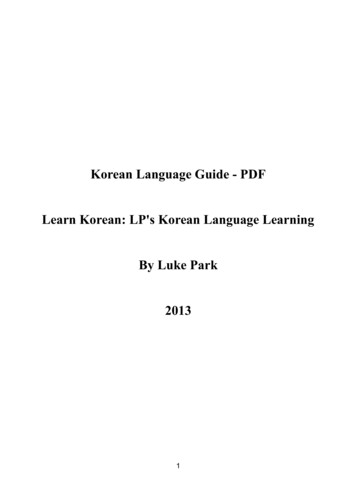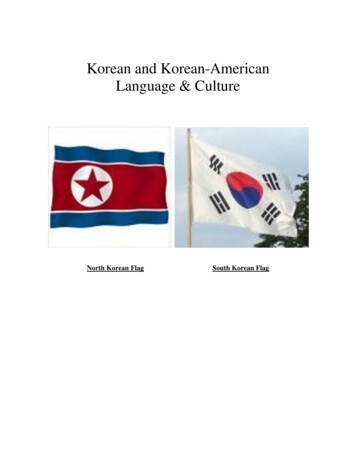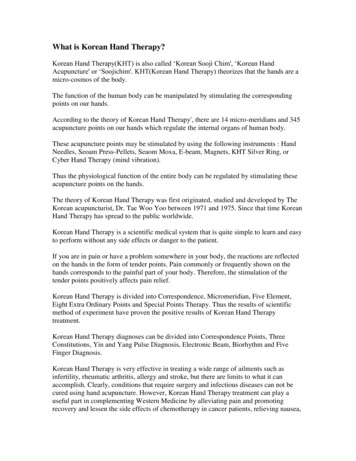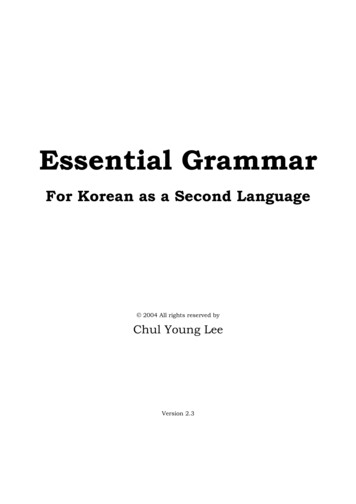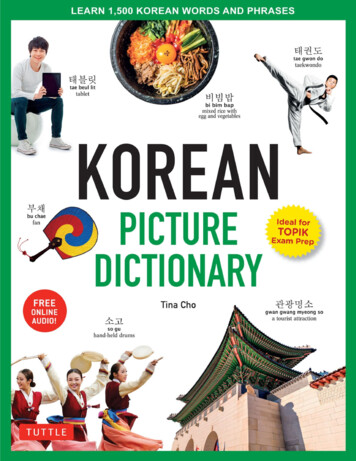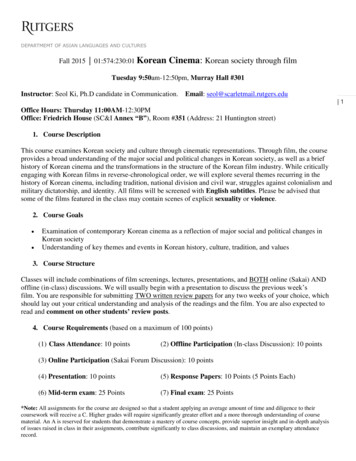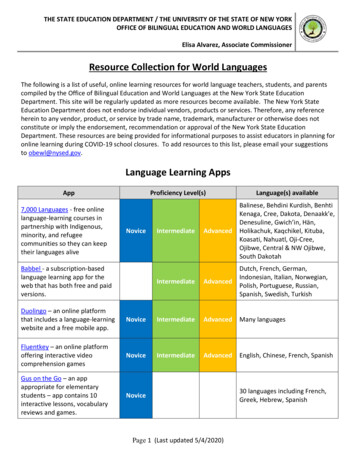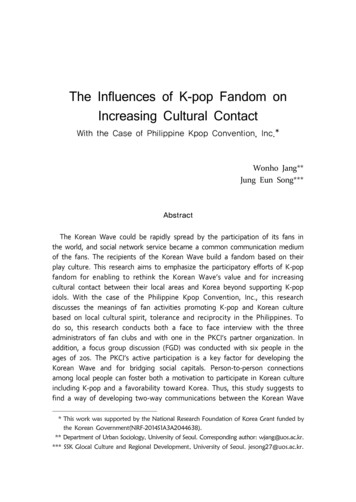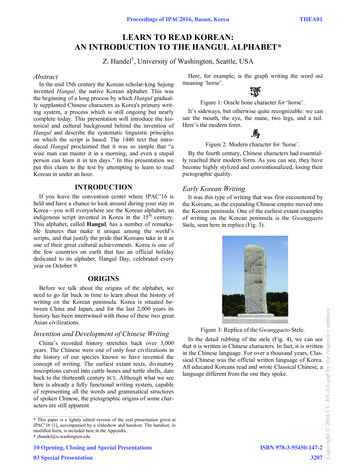
Transcription
Proceedings of IPAC2016, Busan, KoreaTHEA01LEARN TO READ KOREAN:AN INTRODUCTION TO THE HANGUL ALPHABET*Z. Handel†, University of Washington, Seattle, USAAbstractIn the mid 15th century the Korean scholar-king Sejonginvented Hangul, the native Korean alphabet. This wasthe beginning of a long process by which Hangul gradually supplanted Chinese characters as Korea's primary writing system, a process which is still ongoing but nearlycomplete today. This presentation will introduce the historical and cultural background behind the invention ofHangul and describe the systematic linguistic principleson which the script is based. The 1446 text that introduced Hangul proclaimed that it was so simple that “awise man can master it in a morning, and even a stupidperson can learn it in ten days.” In this presentation weput this claim to the test by attempting to learn to readKorean in under an hour.INTRODUCTIONIf you leave the convention center where IPAC’16 isheld and have a chance to look around during your stay inKorea—you will everywhere see the Korean alphabet, anindigenous script invented in Korea in the 15th century.This alphabet, called Hangul, has a number of remarkable features that make it unique among the world’sscripts, and that justify the pride that Koreans take in it asone of their great cultural achievements. Korea is one ofthe few countries on earth that has an official holidaydedicated to its alphabet: Hangul Day, celebrated everyyear on October 9.Here, for example, is the graph writing the word mǎmeaning ‘horse’.Figure 1: Oracle bone character for ‘horse’.It’s sideways, but otherwise quite recognizable: we cansee the mouth, the eye, the mane, two legs, and a tail.Here’s the modern form.Figure 2: Modern character for ‘horse’.By the fourth century, Chinese characters had essentially reached their modern form. As you can see, they havebecome highly stylized and conventionalized, losing theirpictographic quality.Early Korean WritingIt was this type of writing that was first encountered bythe Koreans, as the expanding Chinese empire moved intothe Korean peninsula. One of the earliest extant examplesof writing on the Korean peninsula is the GwanggaetoStele, seen here in replica (Fig. 3).Before we talk about the origins of the alphabet, weneed to go far back in time to learn about the history ofwriting on the Korean peninsula. Korea is situated between China and Japan, and for the last 2,000 years itshistory has been intertwined with those of these two greatAsian civilizations.Invention and Development of Chinese WritingChina’s recorded history stretches back over 3,000years. The Chinese were one of only four civilizations inthe history of our species known to have invented theconcept of writing. The earliest extant texts, divinatoryinscriptions carved into cattle bones and turtle shells, dateback to the thirteenth century BCE. Although what we seehere is already a fully functional writing system, capableof representing all the words and grammatical structuresof spoken Chinese, the pictographic origins of some characters are still apparent.ġFigure 3: Replica of the Gwanggaeto Stele.In the detail rubbing of the stele (Fig. 4), we can seethat it is written in Chinese characters. In fact, it is writtenin the Chinese language. For over a thousand years, Classical Chinese was the official written language of Korea.All educated Koreans read and wrote Classical Chinese, alanguage different from the one they spoke.* This paper is a lightly edited version of the oral presentation given atIPAC’16 [1], accompanied by a slideshow and handout. The handout, inmodified form, is included here in the Appendix.† zhandel@u.washington.edu10 Opening, Closing and Special Presentations03 Special PresentationISBN 978-3-95450-147-23207Copyright 2016 CC-BY-3.0 and by the respective authorsORIGINS
THEA01Proceedings of IPAC2016, Busan, Koreacould master it in the space of a morning, and even astupid person could learn it after a week’s study.So what are these scientific principles? Figure 5 is apage from the section of the text laying out the individualconsonant letters and their sound values.ġġFigure 4: Detail from rubbing of the Gwanggaeto Stele.Over time, the Koreans learned to adapt Chinese characters to represent the spoken Korean language. But thiskind of writing had only limited application. ClassicalChinese remained the official written language, much asLatin was the official written language of most of Europein the Middle Ages, while spoken Korean could only beawkwardly and imperfectly rendered using Chinese characters. This was all to change in the 15th century.ġCopyright 2016 CC-BY-3.0 and by the respective authorsKing Sejong and HangulKing Sejong the Great ascended the throne of the Korean Joseon dynasty in 1418, ruling until his death in 1450.He was a polymath, proficient in literary arts, scientificinvestigation, and military matters. A massive statue,erected in Seoul in 2009, sits above an underground exhibition hall that is dedicated to his life and his manyachievements. Of these achievements, the invention of thealphabet stands as his most enduring legacy.When announcing the alphabet to the Korean people,Sejong explained his motivation this way: “The languageof our nation is different from that of China and is notcompatible with Chinese characters. As a result, the concerns of the ordinary illiterate people cannot be easilycommunicated to their rulers. Saddened by this, I haveinvented twenty eight letters. It is my desire that all thepeople may easily learn them and use them daily.”By the way, if you have any Korean 10,000-won billsin your possession, you have been walking around with apicture of King Sejong in your pocket.The original name of the alphabet was “Correct Soundsfor Enlightening the People”. King Sejong, aided by asmall group of advisors, invented it in 1443 and promulgated it in 1446. It was accompanied by an explanatorytext explaining the principles underlying its invention andgiving examples of its proper usage.ġAlphabetic PrinciplesWhat is perhaps most remarkable about the alphabet isthat the shapes of the letters themselves were chosenbased on scientific principles, including a highly sophisticated understanding of articulatory phonetics. Yet it wasremarkably simple to learn and use. One of the king’sadvisors said, without exaggeration, that a wise personFigure 5: Hunmin jeongeum.Let me draw your attention to the three letters at theupper left. Note their similarity of shape. These letters arean iconic representation of the position of the tonguewhen articulating certain sounds.The four consonant sounds n, d, t, and l are all pronounced with the tip of the tongue angled up to makecontact with the alveolar ridge, the hard bony structurejust behind the upper teeth. If you pronounce all fourconsonant sounds, you can feel where your tongue ismaking contact with the roof of your mouth. The place isthe same for all four sounds. Try saying them betweentwo a vowels: ana, ada, ata, ala.Because these sounds are all pronounced in the sameplace in the mouth, their letter shapes are all based on thesame simple form, representing the position of the tongue.To distinguish the letters, additional strokes are addedonto the base form.This connection between letter shapes and tongue gestures is unique among writing systems of the world. Itresults in an alphabet for which sounds that sound similarare represented by letters that look similar.As another example, consider the letters for the g and ksounds. These sounds are pronounced similarly and soundsimilar. For this reason they are written with similar letters: ጄ and ጞ, respectively; the latter is derived from theformer by the addition of an extra stroke.A second unique feature of the Korean alphabet is thecombination of letters into syllable blocks. Let me showyou how this works. The city name Busan contains fivesounds: the consonant sound b, the vowel sound u, consonant s, vowel a, consonant n.In the Hangul alphabet, these five sounds are writtenlike this: ጕጯጘጢጇ. However, this linear string of fiveletters is not how Busan is written in Korean. Busan ismade up of two syllables, Bu and san. The letters of eachsyllable are combined into a rectangular shape, like so:ꜵꩥ.ISBN 978-3-95450-147-2320810 Opening, Closing and Special Presentations03 Special Presentation
Proceedings of IPAC2016, Busan, KoreaThe Chinese characters 摫 , meaning “Cauldron Hill”were the way that Busan was originally written before theinvention of the alphabet. There is one rectangular character for each syllable, a structure imitated by the arrangement of the Korean letters.MODERN USAGEThrough much of the 20th century, the Korean languagehad a mixed-script writing system, employing both Hangul letters and Chinese characters side-by-side. Figure 6,a Korean newspaper from the 1980s, shows the mixedscript usage.Figure 6: Chosun Ilbo of April 11, 1984.Within the same headline, some Korean words are written in Chinese characters and some in the Korean alphabet. Nowadays, however, Chinese characters have almostcompletely fallen out of use in Korean writing. This isfortunate for foreign learners interested in reading Korean.The letter representing the initial consonant sound iswritten at the top or top left. In this case, the letter ጘ forthe s sound is at the top left.The letter representing the vowel sound is written below or to the right of the initial, depending on its shape.Vertically-oriented vowels, like ጢGhere writing the sounda, are written to the right.The letter representing the final consonant sound iswritten at the bottom. In this case, it is ጇ for n.Reading and Transcribing Korean WritingTo read a syllable, look up the value of each letter depending on its position. Use Tables 1-3 on the handout toget the correct transcriptional value.Let’s practice by reading the word ꊝ렞. Obviously,even if we can make out the pronunciation, we can’t understand the meaning of Korean words that we haven’tlearned. So we will work with words that are recognizableto us because they have been borrowed into Korean fromEnglish or other European languages. This word is a borrowing from English, and is related to the stock market.Breaking down the syllables blocks we arrive at thissequence of letters:ጕ ጴ ጌ , ጌ ጯ , ጝ ጶ ጕ Checking the tables in the handout, and mindful ofwhether consonant letters appear in initial or final position, we arrive at the following transcription.beulluchipFollowing the note on the handout reminding us that eurepresents a vowel similar to that in English bull, we canrecognize that this is the Korean word for ‘blue chip(stock)’. Because of the systemic constraints of Koreanpronunciation, the initial bl- cluster of English has beenbroken up with the insertion of the ‘default’ vowel eu.Note that the way we transcribe and pronounce a Korean letter depends on its position in the syllable. In thisexample, the same letter ጕ writes a b sound at the beginning of a syllable and a p sound at the end of a syllable.READING HANGULCONCLUSIONNow it’s time for us to practice reading Hangul. Forthis you will need to consult the handout (Appendix 1).Invented by a single person at a single time, the Koreanalphabet is highly systematic. It is unique among theworld’s scripts in several respects: the iconic consonantletter shapes that imitate the physical organs of speechproduction; the correlation between similarity of lettershape and similarity of pronunciation; and the grouping ofletters into syllable blocks.Because of this high degree of systematicity, the Korean alphabet is relatively easy for foreigners to learn. Evenwithout a knowledge of the Korean language, foreignvisitors to Korea can benefit from a basic knowledge ofthe script to help them recognize place names, Europeanlanguage borrowings, and signage.For more information on the Korean alphabet, see theWikipedia entry [2], the web site of the National Instituteof Korean Language [3], and Kim-Renaud [4]. On theISBN 978-3-95450-147-2Korean Syllable StructureIn order to correctly interpret the sound values of Korean letters, we need a basic understanding of Korean syllable structure. As shown on the first page of the handout,Korean syllables have three parts: an initial consonant, amedial vowel, and a final consonant. Only the vowel mustbe present in all syllables.The arrangement of letters in a syllable block followsthe syllable structure. Recall the written form ꩥ of san,the second syllable of Busan, which we will use as anexample.10 Opening, Closing and Special Presentations03 Special Presentation3209Copyright 2016 CC-BY-3.0 and by the respective authorsWhy are the letters arranged this way, instead of linearly as in most alphabets? The original reason is the influence of Chinese writing. Chinese characters occupy anotional rectangle, and each represents one syllable. Theidea that syllables are self-contained graphic units is anatural outcome of being literate in Chinese. ArrangingKorean letters in syllable blocks also allowed for an aesthetically pleasing way of intermixing Chinese charactersand Hangul letters within a single text, in which eachgraphic unit represents a single syllable of speech.THEA01
THEA01Proceedings of IPAC2016, Busan, KoreaCopyright 2016 CC-BY-3.0 and by the respective authorsKorean language in general, including its relationship towriting, see Lee and Ramsey [5]. For more on the alphabet’s inventor King Sejong, consult his biographies [6, 7].Table 1: Initial Consonant Letters1ጄg2ጇnAPPENDIX3ጊdThis appendix is a modified version of the handout thatwas distributed as part of the oral presentation.4ጌr (l)Korean Syllable Structure5ጔmKorean syllables consist of three parts:x (I) Initial: the beginning consonant soundx (V) Vowel: the vowel soundx (F) Final: the ending consonant soundNot all syllables have initials and finals; only the vowelmust be present.x The second syllable san of Busan has initial s, vowela, and final n.x The first syllable bu of Busan has initial b and vowelu; it has no final.x The second syllable ul of Seoul has no initial; it hasvowel u and final l.x The word o ‘five’ consists only of a vowel; it has noinitial or final.6ጕb 7ጘs8ጚ--9ጛjssጙthis dummy letter must be writtenwhen there is no initialjjchጜጝ10ጡhጅkkጞktttጋጟuse l only when the precedingsyllable ends in lppጠpTable 2: Vowel LettersCombinationsVertical letters (ጶጶ shape)1ጢaጤyaጫwa2ጦeoጨyeoጰwoKorean Letters, Sounds, and Romanization3ጶiThere are currently three widely used Romanizations ofKorean: Yale, McCune-Reischauer, and the Revised Romanization. The Revised Romanization became SouthKorea’s official Romanization in 2000, and is usedthroughout.The Romanized form of a Korean letter depends on twofactors: its position in the syllable and the letters that areadjacent to it. Tables 1-3 list the Romanized equivalentsof Hangul letters according to syllable position.4ጣaeጥyaeጬwae5ጧeጩyeጱweISBN 978-3-95450-147-23210Horizontal letters ( ጴ shape)6ጪoጮyoጭoe7ጯuጳyuጲwiThree of the simple vowel sounds are Romanized withtwo letters. It is important to remember that the followingdigraphs represent single sounds:x eo ጦ similar to the vowel sound in the Englishwords hum, bud, e.g. Seoul, Incheonx ae ጣ similar to the vowel sound in the Englishwords head, bell, e.g. Taegwondox eu ጴ similar to the vowel sound in the Englishwords good, bull, e.g. Hangeul ‘Hangul’10 Opening, Closing and Special Presentations03 Special Presentation
Proceedings of IPAC2016, Busan, t10ጡtጅጙkጞkጟtጠpጝttFor simplicity, double-letter finals like ግ (lk) and (ps) are not listed here, even though they do occur insome syllables.Assembling Korean Letters into Syllable BlocksFor simplicity, double-letter finals like ግ (lk) and (ps) are not listed here, even though they do occur insome syllables.All syllable blocks are written in identically-sized notional rectangles. The letter shapes may be slightly distorted in order to fit together attractively within the rectangle.The Hangul initial letter is written at the top and the final letter is written at the bottom. The relative position ofall the letters depends on the graphic shape of the vowelletter:x Vertically-oriented vowel letters are written to theright of the initial: san ꩥx Horizontally-oriented vowel letters are written belowthe initial: bu ꜵx Combination vowel letters are written both belowand to the right: wi 낹 (second syllable of kiwi, thetype of fruit)The six most common arrangements of written lettersinto syllable blocks are show in Table 4.Table 4: Syllable Block ConfigurationsIII V 閵 gaV 隱 gwa隕 go VVIIVVV閹 gan隙 gon 隵 gwanFFFA final note: This description is highly over-simplified!Many details have been omitted.IVExercises1) Using Tables 1-3 above, rewrite the following Korean place names and personal names in Romanized form.10 Opening, Closing and Special Presentations03 Special Presentation(a) Identify the initial letter I. It will be at the top or thetop left of the syllable block.(b) Find the initial letter I in Table 1, and copy downthe Romanized form.(c) Identify the vowel letter or letter combination V. Itwill be below the initial, to the right of the initial, or bothbelow and to the right.(d) Find the vowel letter(s) V in Table 2, and copydown the Romanized form.(e) There may not be a final letter F. If there is one, itwill always appear at the bottom below the vowel.(f) Find the final letter F in Table 3, and copy down theRomanized form.Important The same consonant letter may be Romanized differently depending on whether it is in initialor final position. Be sure to consult the correct table!Important When the letter ጚ appears in initial position, it represents no sound and so nothing should betranscribed. When it appears in final position, it represents the sound ng.It takes some practice to identify the individual letterswhen they are squished together within a syllable block,so take your time and don’t be discouraged.a. ꜵꩥb. 끭c. 넭뙑d. 붡뼢e. ꫭ눺f. 뵾꽆g. 뾹鲵The Hangul initial letter is written at the top and the final letter is written at the bottom. The relative position ofall the letters depends on the graphic shape of the vowelletter:2) The following Korean technical terms are borrowedfrom English or other European languages. After Romanizing them, match them to their English equivalents.a. 넩꿝1. wormholeb. 낑뿵2. black hole3. internetc. 陁鬽4. computerd. 넭뫥髬5. ione. ꅎ뿵6. beamlinef. 뢩뺝뫥7. genomeg. 렞8. energyh. 꾅骽덵9. chipi. ꠉꄱ넭If you are sitting near a Korean speaker, ask him or herto pronounce the Korean words out loud. You will noticethat some changes in pronunciation have taken place inthe adaptation of the foreign words to fit the restrictionsof the Korean sound system.ISBN 978-3-95450-147-23211Copyright 2016 CC-BY-3.0 and by the respective authorsTable 3: Final Consonant LettersTHEA01
THEA01Proceedings of IPAC2016, Busan, KoreaREFERENCES[1] Z. Handel, “Learn to Read Korean: An Introduction to theHangul Alphabet”, presented at the 7th Int. Particle Accelerator Conf. (IPAC’16), Busan, Korea, May 2016, paperTHEA01, this conference.[2] Revised Romanization of Korean,https://en.wikipedia.org/wiki/Revised Romanization of Korean[3] Romanization of Korean,http://www.korean.go.kr/front eng/roman/roman01.doCopyright 2016 CC-BY-3.0 and by the respective authors[4] Y.-K. Kim-Renaud, Ed., The Korean Alphabet: Its Historyand Structure. Honolulu, HI, USA: University of Hawai’iPress, 2002.[5] I. Lee and S. R. Ramsey, The Korean Language. Albany,NY, USA: SUNY Press, 2000.[6] Y.-K. Kim-Renaud, King Sejong the Great: The Light ofFifteenth Century Korea. Seoul, Korea: International Circleof Korean Linguistics, revised edition, 1997.[7] Sejong Daewang Ginyeom Saeophoe, King Sejong theGreat: a Biography of Korea’s Most Famous King. Seoul,Korea: King Sejong Memorial Society, 1970.ISBN 978-3-95450-147-2321210 Opening, Closing and Special Presentations03 Special Presentation
Through much of the 20 th century, the Korean language had a mixed-script writing system, employing both Han-gul letters and Chinese characters side-by-side. Figure 6, a Korean newspaper from the 1980s, shows the mixed-script usage. Figure 6: Chosun Ilbo of April 11, 1984. Within the same headline, some Korean words are writ-

